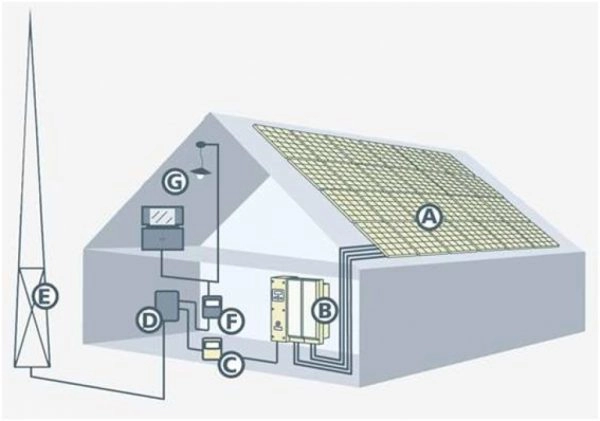Grid Connected (On Grid)
The most popular photovoltaic electricity generation application in the world is the transfer of power obtained from PV panels on the roofs and facades of buildings to the electricity grid. In this application, the photovoltaic power generation system works like a mini power plant. The electricity produced from photovoltaic panels is sold to the grid at a separate tariff through a separate meter.
This application is called grid-connected photovoltaic electricity generation system application. Although there is a mains connection in some island systems, this connection is used to charge the batteries with the power taken from the mains. The grid connected system mentioned here transfers photovoltaic power to the grid, unlike the island system, and the term grid link is used to describe a power flux to the grid.
The main advantages of installing mini solar power plants in such a dispersed structure are the reduction of energy transmission losses as a result of generating electricity close to where it is consumed, and compensating for the peak power requirement caused by air conditioning devices, especially in sunny areas. The increase in oil prices and the global warming experienced in recent years have pushed countries to seek new solutions to these problems. Among these solutions, a trend towards renewable energies stands out.
The main advantages of installing mini solar power plants in such a distributed structure are the reduction of energy transmission losses as a result of generating electricity close to where it is consumed, and compensating for the peak power requirement caused by air conditioning devices, especially in sunny areas. The increase in oil prices and the global warming experienced in recent years have pushed countries to seek new solutions to these problems. Among these solutions, a trend towards renewable energies stands out.
Due to the high initial investment costs of renewable energies, various legal arrangements have been made to expand these systems. The main reason why grid-connected solar energy systems have become widespread in the world market by 85% is the high-priced solar electricity purchase tariffs and purchase guarantees applied in some developed countries.
Grid Connected System Design
1- The power of the system is not limited by the need, but by the size of the area where the PV panels can be installed or the budget allocated for the establishment of this system. Since the electricity produced will be sold at a high-priced tariff, an attempt is made to establish a system as large as possible. 2- Selection of PV Module technology: Different PV technologies have different efficiencies, temperature losses and efficiencies under low heating conditions. All parameters need to be evaluated. 3- Choosing the installation location of the system and the appropriate mounting construction (roof mounting, fixed angle open area mounting, façade mounting, using a sun tracking system, etc.) Determining and calculating the amount of shadow caused by the movement of the sun throughout. 5- Determination of the inverter (inverter) concept 6- Calculation of the inverter (inverter) power. 7- Calculation of the inverter voltage 8- Determination of the number of parallel PV array groups 9- Creation of the cabling infrastructure.
Typical photovoltaic energy production and consumption profiles of a grid-connected house


